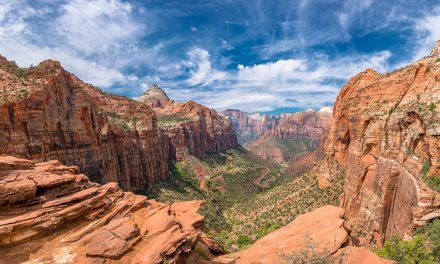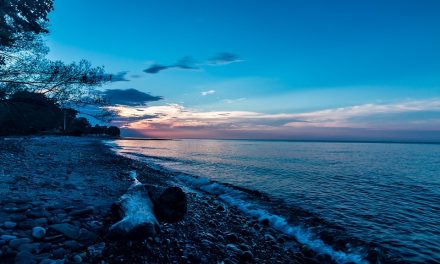With its signature Joshua trees, massive boulders, desert valleys, and open skies, Joshua Tree National Park is a place unlike any other. Camping in Joshua Tree National Park is the best way to get to know this unique region of Southern California. There are nine Joshua Tree camping grounds within the park boundaries and several more in the surrounding area.
As Joshua is just a couple of hours from San Diego, between the Colorado and Mojave Deserts, it’s a popular place in all seasons, but particularly between September and May. To make sure that there’s space for you and your tent or camper, you might need to plan and reserve a campsite.
Which are the best places to camp in Joshua Tree National Park? In this article, we’re going to answer that question and give you all the information you need to prepare for Joshua Tree camping.
#1 – Jumbo Rocks Campground

Jumbo Rocks Campground is one of the most popular, family-friendly Joshua Tree camping spots. It’s located centrally but is closest to the northern park entrance. It’s next door to epic granite boulders and rock formations that are great for climbing and scrambling.
Because of this, it’s always busy in the high season, September to May, and you’ll need to book a campsite in advance unless visiting in the calmer summer months. That said, it’s also the largest campground at Joshua Tree, with 124 campsites that can accommodate RV’s, trailers, and tents. If you’re planning a last-minute getaway, then Jumbo Rocks Campground is the most likely to have available campsites.
Campground Info
Nearest Entrance: North entrance
Open: Year-round
Reservations: Required from the end of August to the beginning of June
Total Campsites: 124
Cost: $20
Facilities
- Pit toilets
- Tables and fire grates
- Trash/recycling collection
#2 – Hidden Valley Campground
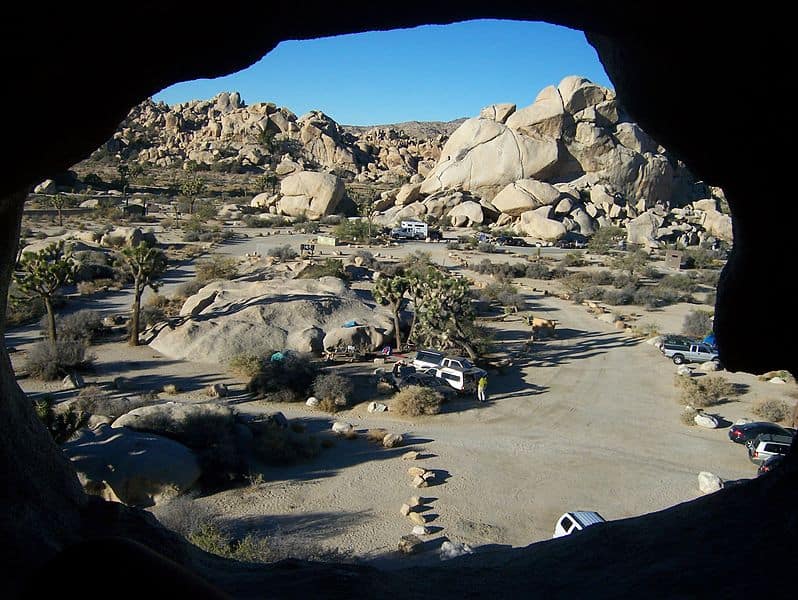
Without a doubt, the best campground for climbers is Hidden Valley Campground because it’s so close to the parks climbing routes. It’s also a convenient base camp for hiking the Hidden Valley Nature Trail. Another reason that Hidden Valley campground makes it into our top five is that there’s no cell service and generators are not allowed. You can fully enjoy the sounds of the desert at night.
It’s also centrally located in the park; close to several of Joshua Tree’s highlights and the visitor center. Although you don’t need a reservation to sleep at Hidden Valley Campground, it’s still one of the most popular campgrounds in the park. If you want to camp here in the busy season, you’ll need to arrive in the morning.
Campground Info
Nearest Entrance: West entrance
Open: Year-round
Reservations: Not needed
Total Campsites: 44
Cost: $15
Facilities
- Pit toilets
- Tables and fire grates
- Trash/recycling collection
#3 – Belle Campground
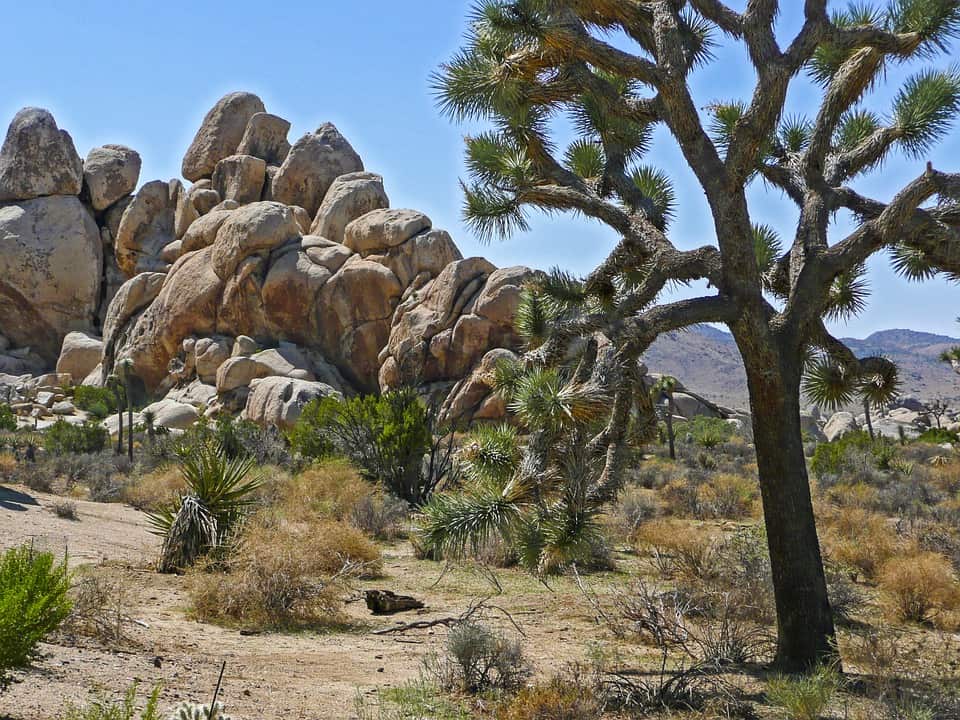
Belle Campground is another first come, first serve campground. It’s located in the northern reaches of the park and only offers 18 campsites. The most impressive sights here are the pyramid-like mounds of bounders that interrupt the desert landscape. Like Hidden Valley Campground, generators are not allowed, and Belle Campground is a fantastic camping spot for seeing the night sky. It’s also an excellent base for climbers and for anyone who prefers to avoid crowded campgrounds.
Campground Info
Nearest Entrance: Northern entrance
Open: Year-round
Reservations: Not needed
Total Campsites: 18
Cost: $15
Facilities
- Pit toilets
- Tables and fire grates
- Trash/recycling collection
#4 – White Tank Campground
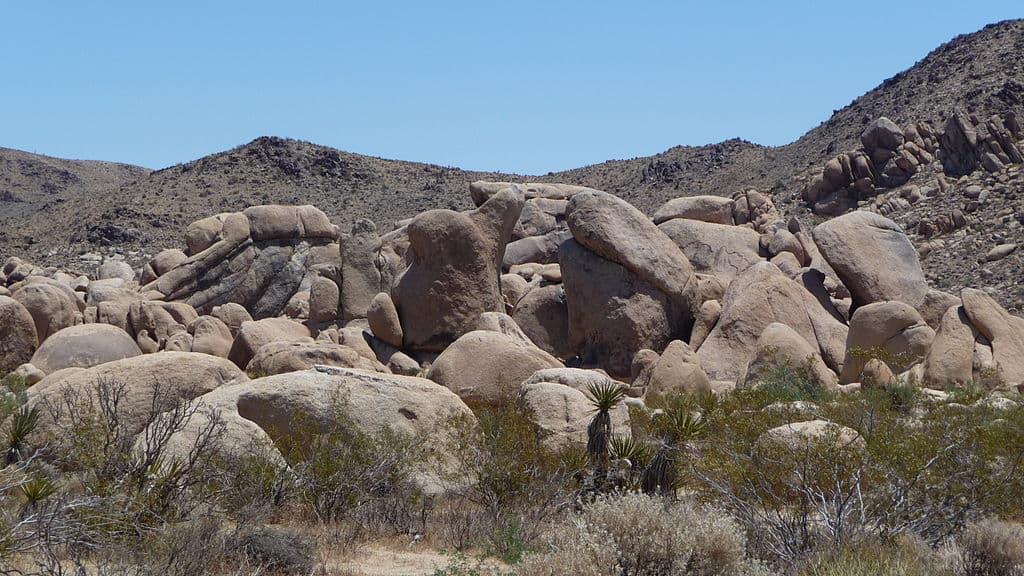
White Tank Campground is an even smaller first come, first serve campground, located just down the road from Belle Campground. The boulders scattered about the campground make fun scrambling challenges for both kids and adults. Plus, the Arch Rock Nature Trailhead is close by so you can go for a gentle hike.
As White Tank campground is slightly further away from the top attractions, this campground is probably the best for stargazing. There are only 15 first come, first serve campsites available here so you’ll need to arrive early in the day or visit in the quiet season. Either way, camping in this remote section of Joshua Tree is hugely rewarding.
Campground Info
Nearest Entrance: Northern entrance
Open: Year-round
Reservations: Not needed
Total Campsites: 15
Cost: $15
Facilities
- Pit toilets
- Tables and fire grates
- Trash/recycling collection
#5 – Black Rock Campground
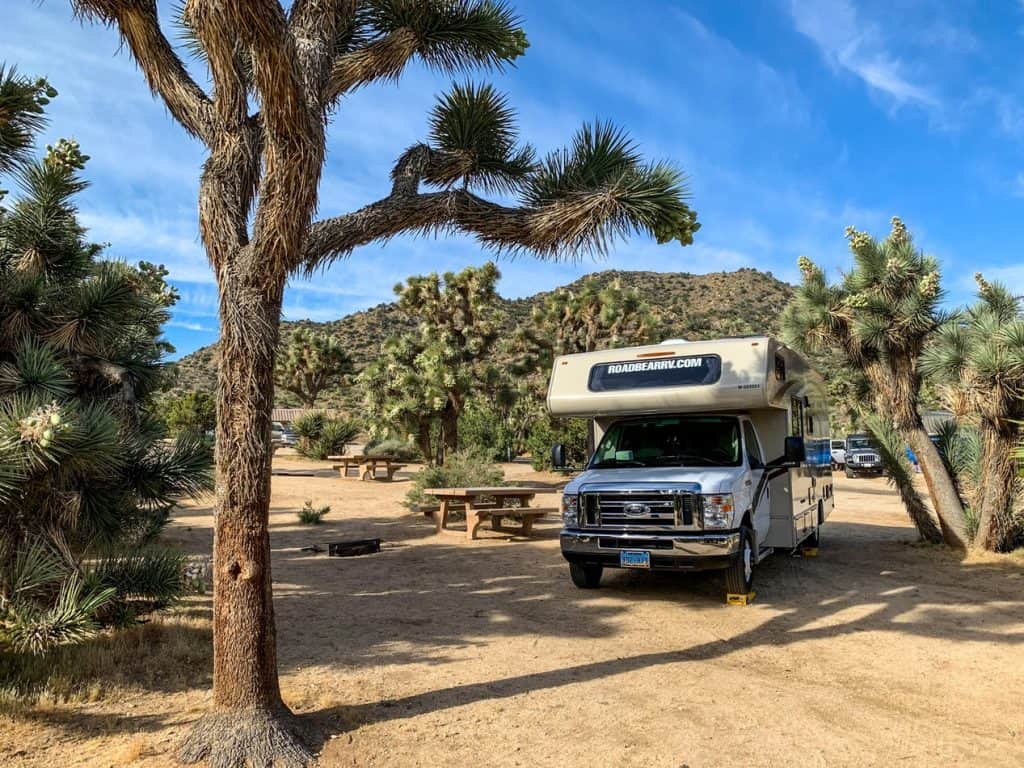
If you prefer to have a few more creature comforts when you’re camping, then we recommend Black Rock Campground. It has both potable water and flushing toilets. Camping generators are also allowed at specific times of the day so remember to pack yours. Plus, it’s the third-largest campground in the park so, like Jumbo Rocks Campground, you’ll have a better chance of getting a campsite if you didn’t plan ahead.
The campground is close to Yucca Valley. At night you can see the small-town lights but in the daytime there are fantastic views of the San Bernardino Mountains.
Instead of climbers, Black Rock Campground is the best Joshua Tree camping spot for bird watchers or anyone exploring the park on horseback. Black Rock Campground has a separate area for horses and their owners. Of our top five Joshua Tree camping spots, Black Rock Campground is the only one that closes in the summertime (June to August).
Campground Info
Nearest Entrance: Northern entrance
Open: September to May
Reservations: Reservation only
Total Campsites: 99
Cost: $25
Facilities
- Portable water
- Flush toilets
- Tables and fire grates
- Dump station and trash/recycling collection
Other Joshua Tree Campgrounds
Above we’ve listed the best Joshua Tree camping spots but if you prefer to make your own decision, that’s okay! Below is a quick list of the remaining four campgrounds located within Joshua Tree National Park and the essential information for each.
Cottonwood Campground
Campground Info
Nearest Entrance: South entrance
Open: Year-round
Reservations: Required from the end of August to the beginning of June
Total Campsites: 62
Cost: $25
Facilities
- Portable water
- Flush toilets
- Tables and fire grates
- Dump station, trash/recycling collection
Indian Cove Campground
Campground Info
Nearest Entrance: North entrance
Open: Year-round
Reservations: Required from the end of August to the beginning of June
Total Campsites: 101
Cost: $25
Facilities
- Pit toilets
- Tables and fire grates
- Trash/recycling collection
Ryan Campground
Campground Info
Nearest Entrance: West entrance
Open: September to May
Reservations: Reservation-only
Total Campsites: 32
Cost: $20
Facilities
- Pit toilets
- Tables and fire grates
- Trash/recycling collection
Sheep Pass Group Campground
Campground Info
Nearest Entrance: West entrance
Open: year-round
Reservations: reservation-only
Total Campsites: 6
Cost: $35-$50
Facilities
- Pit toilets
- Tables and fire grates
- Trash/recycling collection
FAQ’s
How much does it cost to camp at Joshua Tree?
Camping costs vary between campgrounds. There are two types of campgrounds; first come, first serve campgrounds, which charge $15 per night, and campgrounds that allow (or require) reservations, which charge either $20 or $25 per night.
Whichever campground you stay in, everyone needs to pay the entrance fee which is $30 per car, $25 per motorbike, or $15 for individuals on foot or bicycle. The entrance fee buys you a 7-day pass. Alternatively, you can buy a $55 annual pass for Joshua Tree or an $80 annual pass for all US national parks and national wildlife refuges.
Can I camp for free in Joshua Tree?
Free camping is not available within Joshua Tree National Park. Even backpackers need to pay for a backcountry permit. However, there are free Joshua Tree camping options just outside the north and south entrances of the park. These are undeveloped free campsites, mostly without facilities, on land managed by the Bureau of Land Management (BLM).
Can I camp anywhere in Joshua Tree?
Because the park has become so popular you might struggle to find an available campsite in the peak season if you didn’t book way in advance. If you’re stuck without a campsite, you might want to pitch your tent anywhere. Unfortunately, that’s not allowed. However, backcountry camping is allowed with a permit.
Is backcountry camping allowed in Joshua Tree?
Yes, if you’re looking to get away from the roads and explore the park on foot, then backcountry camping is permitted. You should first apply for a permit and register at one of the 13 staging areas. According to park rules, you should camp:
- at least 1 mile from any roads
- at least 500 feet from water sources and trails
- outside of day use-only areas
Ideally, you should also avoid camping close to wildlife habitats (burrows and nests) and pitch your tent on stable soil. This helps to protect Joshua Tree’s delicate ecosystem.
Can you sleep in your car in Joshua Tree?
Sleeping in your car next to a road or layby in Joshua Tree National Park is not permitted. If a ranger catches you, then you may be subject to citation, and if you leave your vehicle outside of the designated car parks or campgrounds, it may be towed. If you want to sleep in your car and all the campgrounds are full, then your best option is to park outside of the Joshua Tree boundaries and return in the morning.
Is there a signal at Joshua Tree National Park?
The beauty of camping in the wilderness is that you can really disconnect from modern technology. This is undoubtedly true of Joshua Tree because there’s no phone service across most of the park and the surrounding area. There is some signal close to the park entrances but it’s best not to rely on your cell phone for emergency calls. You can carry a satellite phone or an emergency radio instead.
Additional info for Joshua Tree camping trips
- Apart from Cottonwood Campground and Black Rock Campground, there is no water at any of the campgrounds.
- You should bring enough drinking and washing water to last the length of your stay in Joshua Tree.
- Small campfires are allowed at campgrounds, but you should bring your own firewood.
- There are no shopping or grocery facilities inside the park.
- Most campgrounds are suitable for small-medium sized RV’s, trailers, and tents.
Ready for an adventure?
Now that you know where to set up camp in Joshua Tree National Park, use this guide to plan your trip and take advantage of the best Joshua Tree camping spots.
- 5 Best Water Containers for Camping In 2021 - March 3, 2021
- 5 Best Rooftop Tents For The Outdoors In 2021 - February 5, 2021
- 10 Best US Campgrounds For People Who Don’t Camp - January 17, 2021



